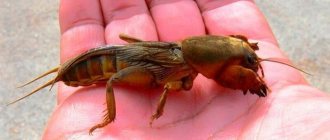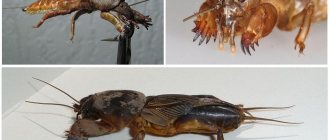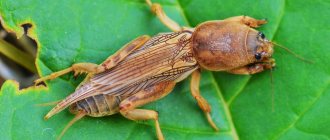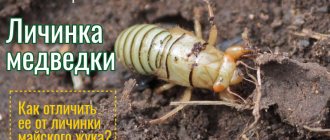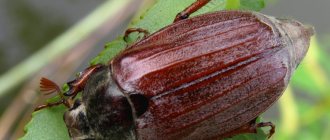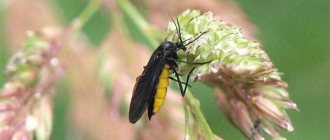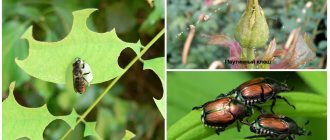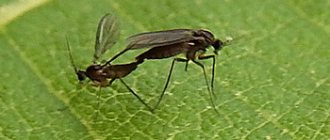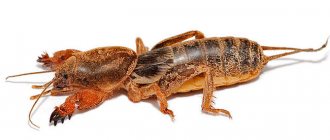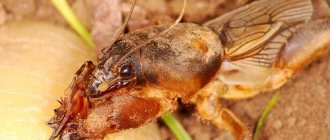Views: 945
There are also plenty of pests in summer cottages and garden plots. An insect like the mole cricket is one of them. Sometimes, multiplying in large numbers, this arthropod causes a lot of trouble for farmers. In this article we will look at the damage it causes and how to get rid of mole crickets in the garden. But first, let’s get to know this pest better: how it lives, what it eats, how it reproduces, where it settles, and so on. We attach a photo of the bear and a description. You need to know the enemy by sight)
Description and photo of the mole cricket close-up
The closest relatives of this insect are grasshoppers and crickets. However, unlike its relatives, it looks very different from them. At least as an adult.
By the way, it is not known for certain where it got its name. One of the versions is due to strong brownish pubescence . Maybe this reminds someone of a bear? At least she is related to the bear by the fact that she is an omnivore. The insect feeds both on plant roots, gnawing them, and on smaller arthropods . But we will talk about this in more detail later, when we consider its significance in human life.
What does a bear look like?
You definitely can’t call her beautiful and graceful (see the photo of the bear next to it). In Latin the insect is called " gryllotalpa " . If translated literally into Russian, it turns out something like “cricket-mole”. It’s probably clear why she is compared to a mole. Most of the insect's life is spent underground. Therefore, its entire body is adapted for digging numerous passages in the soil . The forelimbs have turned into powerful “living shovels” .
They are larger in size with their hind legs, unlike those of their jumping counterparts. For example, grasshoppers. What are the sizes of the bear? We admit that this is a fairly large insect. It reaches 5 centimeters in length. The width of the “waist” is about 1 centimeter. Thus, its shape is quite elongated, elongated . This also allows her to move more easily through the numerous branched underground passages. The head and chest are “chained” in a durable chitinous shell . It helps compact the soil around it as the insect moves through the soil. It is for this that it is safest to take arthropods. But you shouldn’t put your fingers under the massive jaws. The mole cricket bites! After all, she is a predator and can bite quite sensitively .
By the way, mole crickets can move through underground burrows successfully in both directions : both forward and backward. The fact is that at the rear end of the insect’s body there are long sensitive cerci, similar to antennae. They help her navigate when moving in reverse. Thus, the mole cricket is a “two-way” insect.
There are also small antennae on the head. The front legs, as we have already said, are transformed into powerful digging tools . They have an extended shape and are equipped with several teeth at the ends. Such a device allows a dungeon dweller to burrow into the soil very quickly if necessary.
What a talented bear!
Despite the fact that most of its time underground, it is not only capable of digging multi-branched tunnels. The mole cricket can fly remarkably well . Yes, seeing this overweight and ponderous insect, one gets the impression that it is definitely not given the ability to fly. But no! Their wings are quite well developed. Therefore, sometimes in the evenings you can observe mole crickets crawling out of their shelters and rushing towards the light with a loud buzz. Insects cope well with this function and have quite confidently mastered the air spaces. Although it is known that only males are transported in this way. Females refrain from extreme types of movement)
Among other things, at an early age mole crickets also jump , like their closest relatives - grasshoppers. True, they are very shy and hide from the slightest rustle. And in adulthood they lose the ability to jump. But insects swim beautifully throughout their lives .
How does the bear sing?
Like many other brothers (crickets and grasshoppers), the insect is quite “vocal”) The sounds of the mole cricket are very characteristic . Sounds like the chirping of crickets. Like grasshoppers, the hearing organs are not located on the insect's head, but on the front legs . Thus, the forelimbs not only serve as tools for digging holes, but also actively participate in sound production.
It is best to listen to the sound of mole crickets in the evenings. As a rule, animals become active after sunset . Therefore, at this time you have the best chance of going to their concert. The mole cricket makes sounds similar to a fairly loud, but at the same time hoarse trill . It takes quite a long time.
However, this is not the only insect song. In addition to the drawn-out chirping, they can also produce other “notes.” Some sounds of the mole cricket resemble a light, barely perceptible rustling in the silence of the night . It is often addressed to individuals of the opposite sex and is produced predominantly by males. However, females are also not inferior to their partners in melodiousness and from time to time fill the air with short signaling sounds about possible danger.
Thus, you can detect mole crickets on the site by singing at night . This is a fairly reliable criterion for finding insects. We will talk about some other signs indicating the appearance of a mole cricket in the garden below, in the section “How to understand that a mole cricket has appeared on the site?”
Lifestyle of a "beetle"
Where does the bear live? Most often in heavy clay soils. Loves fertile land. Prefers open areas well warmed by the sun's rays . Well, the main thing for her is that there is sufficient humidity. Therefore, these insects are often found in floodplains. However, they also often become inhabitants of gardens, vegetable gardens and summer cottages. Especially where the owners carefully monitor watering and generously fertilize the soil)
In Russia, the mole cricket lives mainly in the European part. The exception is the extreme northern regions. Abroad, it is found in Europe (again, except in the northern regions with perpetually frozen soil). In the south of the Earth, the geography of its distribution reaches the north of Africa.
Mole cricket reproduction
Arthropods breed their offspring in June-July. In the soil, at a depth of about 5-10 centimeters, insects organize a nest . Bears are very caring parents. Therefore, they lay eggs in special spherical chambers with compacted walls, made in soil and moistened with saliva. The diameter of one such cavity is about 8-10 centimeters . In a “family estate” equipped in this way, females lay from 200 to 600 eggs. Fecundity varies among species and also depends on environmental conditions. The mother bear diligently licks her offspring, protecting the eggs and hatched larvae from the proliferation of parasitic fungi on their surface.
Mole cricket larvae are similar in appearance to adult individuals. Just smaller in size. Another difference is slightly different proportions of body parts. For example, the head is usually larger compared to the rest of the animal's body. From the moment of hatching from eggs to reaching adulthood, different species of mole crickets can take from 1 to 2.5 years. During this time, the younger generation molts several times. At first, adult females patiently guard and protect the developing larvae. Their parents leave them approximately after the second molt of their offspring.
How to understand that there is a mole cricket on the site?
#1. In the garden, the mole cricket's passages (its burrows or tunnels can be called differently) that it makes sometimes reach a length of 15 meters. Of course, you can't see them from above. However, its presence on the site can be determined by the presence of soil mounds on the surface of the earth . Under them, as we have already described above, insects organize their nest with offspring.
#2. In addition, an important criterion for detecting mole crickets in the garden is the sudden drying out of young plants for no apparent reason (although not only this insect may be to blame for this). When such plantings are torn out of the ground, it is clearly visible that their root system is either gnawed or heavily gnawed.
#3. Well, another criterion that can serve as a sure sign of the presence of a pest on the site is the night singing of a mole cricket .
#4. If, in addition, it is possible to catch specimens of adult insects , then all doubts should definitely disappear - an uninvited tenant has settled on the site.
The influence of nutrition on reproduction
Any living creature has two main instincts, closely related to each other: reproduction and self-preservation. The second largely depends on the quality of the food consumed. Insects appeared on the planet much earlier than other more delicate forms of life, so they are well versed in matters of survival and are distinguished by endurance and fertility.
This is interesting to know:
High fertility is observed in the mole cricket if it has free access to the underground parts of plants, that is, stems, tubers and root crops. On cultivated land, where there is plenty of food but not enough cereals, reproduction is slower. It's not so much about quantity as it is about quality of food.
Also, the duration of development of the larvae depends on the daily “menu”. It can drag on for one or two years. At least once in its life, an insect will have to survive the cold. Wintering begins in September. To tolerate it well, the mole cricket feeds intensively and accumulates fat. This is especially true for females.
The harm and benefits of mole crickets
This insect can be conditionally called harmful-beneficial . Above, we already briefly mentioned what mole crickets eat. Most of all, she loves to feast on the juicy, tender young roots of herbaceous plants. In addition, it hunts earthworms, caterpillars, ladybird larvae and others.
Based on her food preferences and lifestyle, we can conclude that this arthropod not only harms, but also brings tangible benefits . Here, much depends on the degree of population of the area by mole crickets. We have already described a similar situation in the case of ants. They also have mixed meaning in personal plots. You can read more about this here - Ants in the garden: benefit or harm?
In other words, it’s bad when there are too many mole crickets . However, it is not worth exterminating the insect completely. It is very important in maintaining ecosystems in nature.
Why is mole cricket dangerous?
First of all, you need to know how and how the insect harms. So, let’s briefly note the main points why mole crickets are dangerous on the site:
- The most important thing is damage to the root system of garden and vegetable crops . As a result, the plants simply dry out and die. Thus, if the area is heavily populated by mole crickets, you may be left without a harvest .
- Eating the larvae of beneficial insects (for example, such as ladybugs), earthworms and other orderlies of nature also does not do this predator any honor.
Therefore, it is important to monitor its spread throughout the territory and take “corrective” measures in a timely manner.
What benefits does mole cricket bring in the garden and in people’s lives?
As we have already said, this insect not only harms, but also helps.
- Mole crickets destroy the larvae of cockchafers, butterfly pupae and other garden pests.
- Numerous mole cricket moves made in the ground significantly improve soil aeration . This is especially true in conditions of heavy clay soils.
- Some people use mole crickets for fishing .
- Sometimes lovers of extreme types of pets breed them at home in a nursery .
- There are also people who eat these insects as food and also use them for various diseases.
In the wild, this arthropod is a food source for many birds and mammals.
Prevention
To reduce the appearance of mole crickets on your summer cottage to a minimum, you need to:
- Clear the area of branches, fallen leaves and other debris - after cleaning it will be much easier to detect and destroy the pest.
- Before sowing plants, it is advisable to treat the seeds with Aktara.
- Not far from the site you can plant calendula or chrysanthemum, the smell of which repels cabbage weeds.
- In order for insects to freeze out during cold weather, it is necessary to deep dig the soil in late autumn.
Source
How to get rid of a mole cricket beetle?
Since ancient times, people have taken various measures to combat mole crickets. As they say, we fought with whatever we could. Therefore, today there are many popular approaches to how to get rid of mole crickets . Let’s say right away that not all of them are effective. Moreover, we note that if these insects have settled on the site, it is unlikely that they will be completely eliminated. However, it is quite possible to reduce their numbers to an acceptable level .
In the fight against mole crickets, it makes sense to use folk methods in combination with other means . Namely, using chemistry and various mechanical and electrical traps. And here it is important to find a balance. Folk remedies for mole crickets and traps are more environmentally friendly and safer. But “chemistry” is more effective . Together they make getting rid of the pest most productive.
#1. Folk remedies in the fight against mole crickets
At first - more gentle methods. So, what folk remedies for mole crickets, traps and preventive measures can you try:
- Plants such as marigolds, calendula, and cloves repel many insects . Mole crickets are no exception. They also do not like the strong smell of these flowers and try to stay away from them.
- Coniferous plants have a similar effect . To repel pests, you can lay out individual branches on the surface (and even embed them in the soil). Especially where there are clear signs of the presence of a parasite.
- Alternatively, you can use onion peels, garlic.
- Since the animal loves warmth, in the spring it is recommended to lay out pieces of slate and similar material on the surface of the ground . Insects will gather to bask under them. This will make it possible to catch them directly.
- Trap holes are sometimes made in the ground filled with horse manure . Mole crickets look for such places to overwinter. During the season they gather there, which makes it possible to open these traps at the beginning of winter and move the insects out into the cold. They don't like the cold. Therefore, as a rule, they die.
- It is important to dig up nests found in the ground entirely and destroy them.
These are just some of the pest control methods. There are others. To choose the optimal ones, you will have to try different options .
#2. How to fight mole crickets using “chemistry”
Here, too, there is a certain gradation in the choice of means and approaches. So-called biological products, for example Boverine, are as safe as possible . Whereas more aggressive chemicals (Medvetox, Aktara and others) destroy not only mole crickets, but also many other inhabitants of the soil. Including useful ones.
Therefore, when using “chemistry” you should always be careful. Namely, do not abuse these drugs and strictly follow the instructions for use of the drugs .
conclusions
In conclusion, several conclusions can be drawn:
- Mole crickets love manure, so fertilizing plants with this nitrogenous fertilizer should be avoided.
- Noise, vibration, and ultrasonic repellers are not effective, since in the ground these vibrations spread over a very limited distance.
- With proper prevention, loosening and weeding, mole crickets will be vulnerable and will not be able to harm all plantings.
What means do you use to fight mole crickets?
FolkChemical
Any available means should be used according to the recommendations. The same applies to insecticides. When open passages are identified, drugs are poured directly into this hole. Remember that mole crickets reproduce very quickly and “doing nothing” in relation to these pests equals a lack of harvest and a waste of time and effort.
So, mole cricket in the garden: fight or rejoice?
In small quantities, the presence of mole crickets on the site is very favorable . However, if insect pests in the garden become noticeable, then it is better to take appropriate measures.
You can start with less invasive procedures. For example, plant marigolds around the perimeter or try homemade traps . If it doesn’t help, then move on to more destructive chemicals.
Other articles about insects:
– Fleas in the house: how to get rid of them?
– Biological methods of exterminating insects
– Is it possible to get rid of bedbugs using folk remedies?
Exceptions
Although the mole cricket is practically omnivorous, it does not like some agricultural crops. Which ones exactly? More on this below.
Beans
It is noticed that the insect does not touch the beans. Some gardeners even plant this plant around the perimeter of the plot and claim that after this the cabbage plant does not appear there.
Parsley
The insect feeds on the roots of this plant. However, it is believed that the smell of parsley repels him.
Onion and garlic
The husk of this vegetable, or rather its smell, has a deterrent effect on the mole cricket. In the beds where onions grow, the brown beetle is almost never found.
Garlic repels mole crickets more effectively than any other plant. By planting it on your site, you can be sure that the insect will avoid it.
